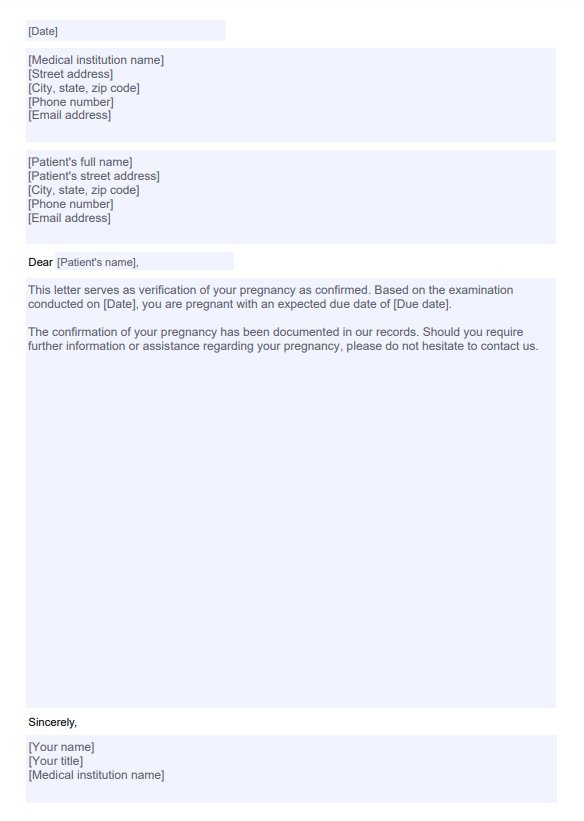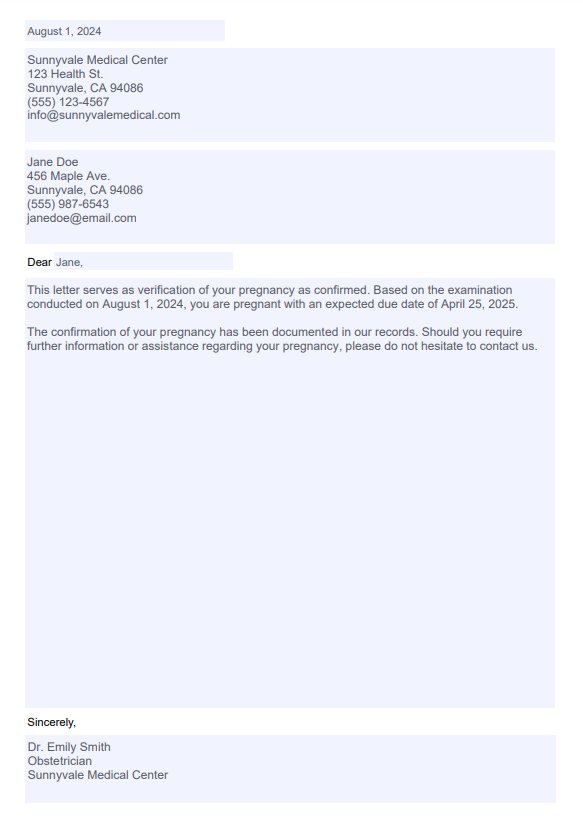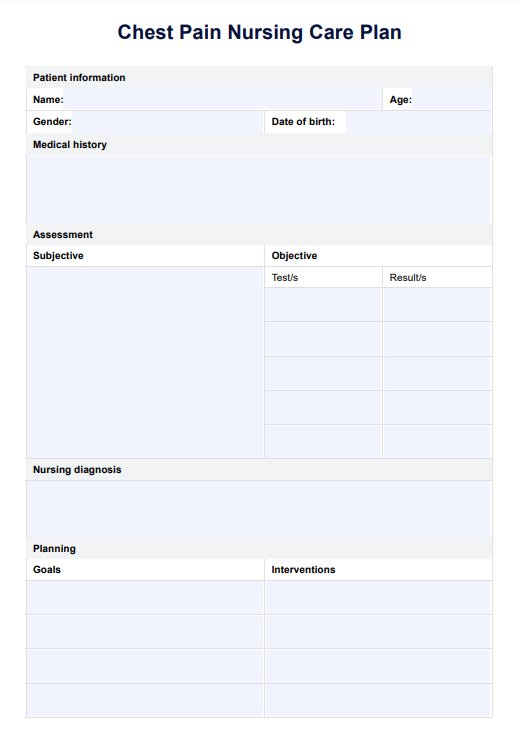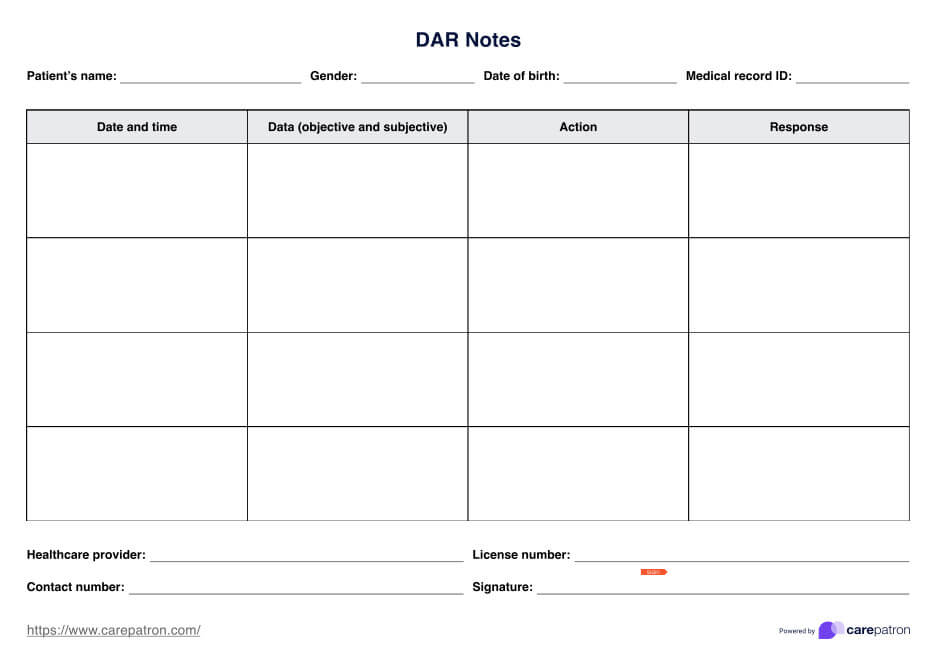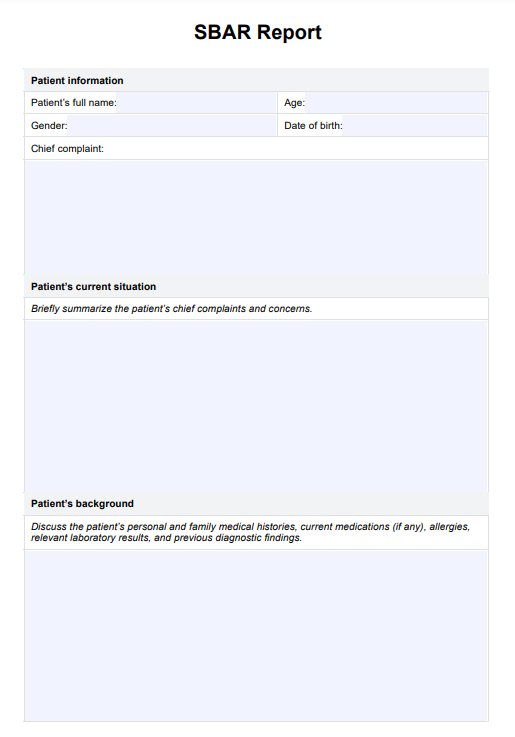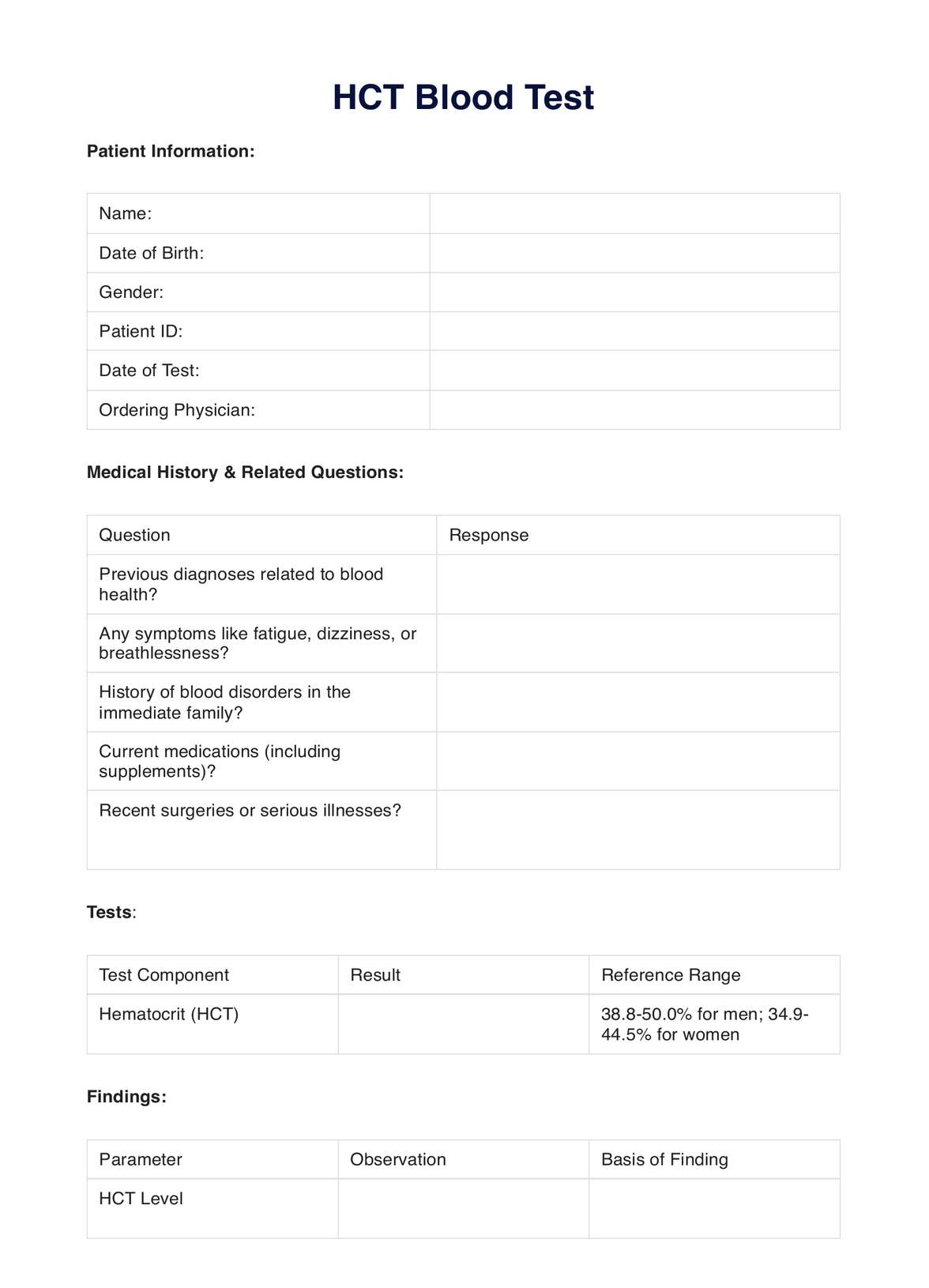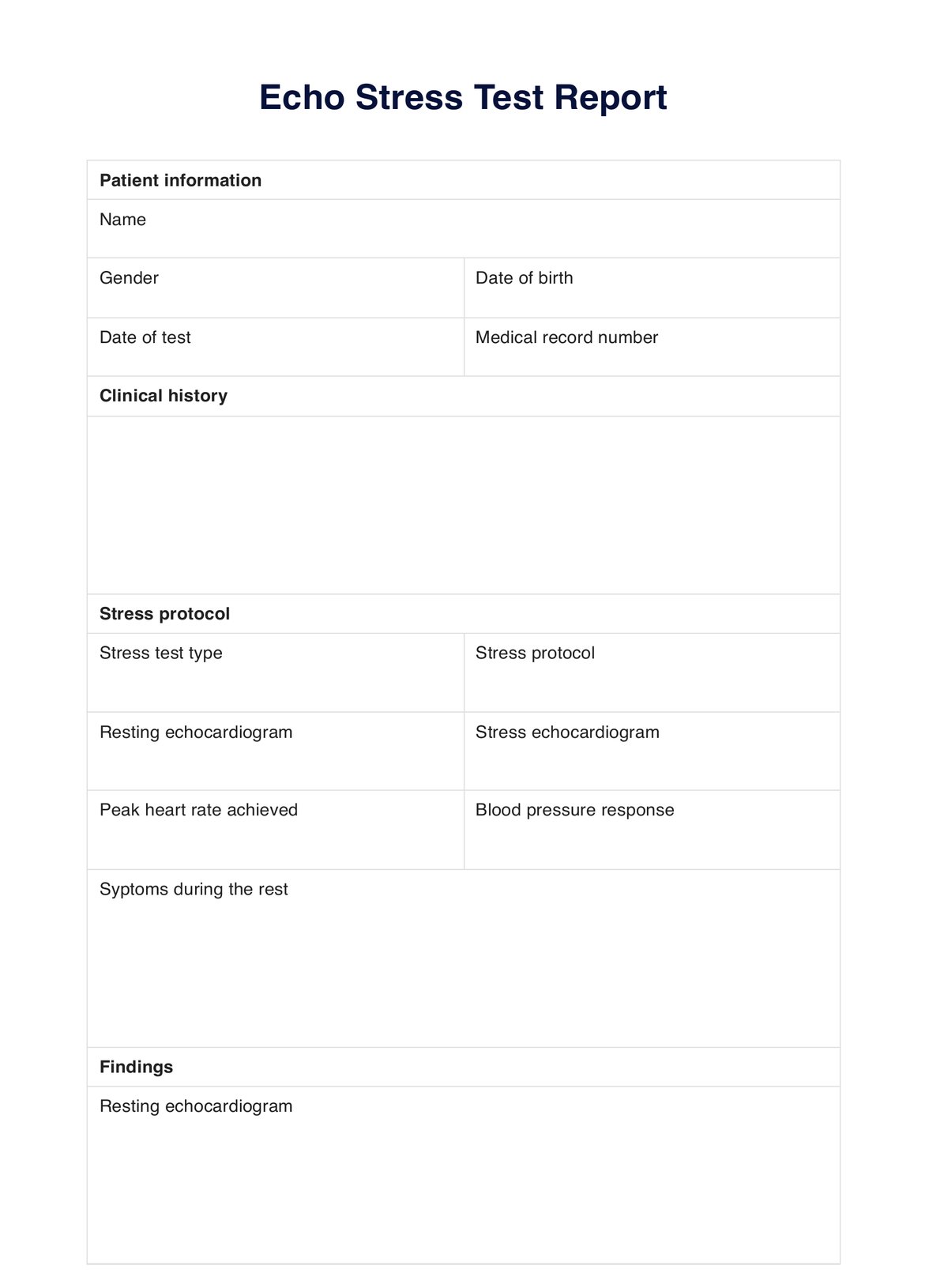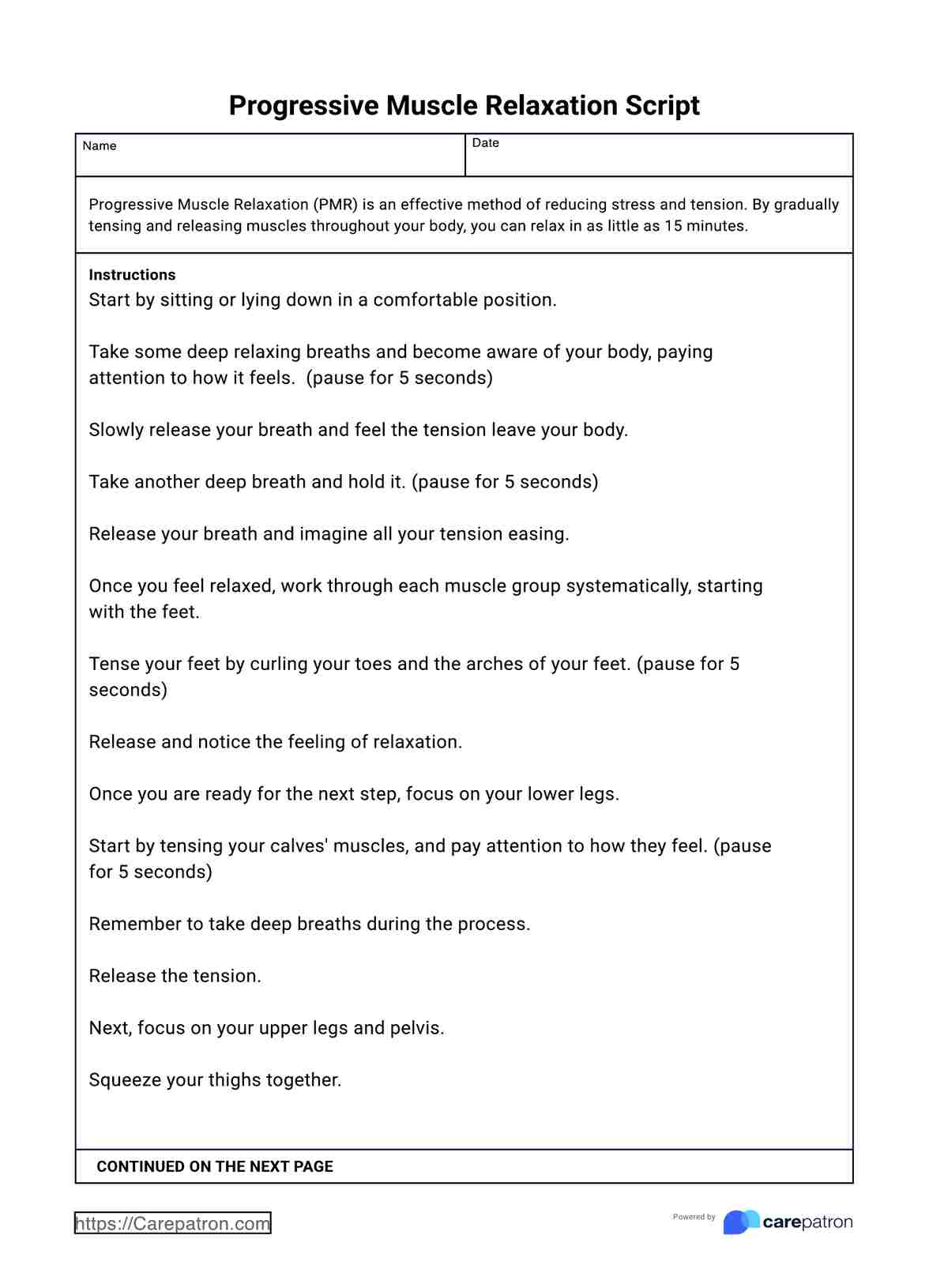Pregnancy Verification Letter
Use our Pregnancy Verification Letter template for a more structured approach to your clinical documentation.


What is a Pregnancy Verification Letter?
A Pregnancy Verification Letter is a medical document signed by a medical professional to confirm that a woman is pregnant. This letter serves as proof of pregnancy and may be requested by employers for maternity leave or travel purposes.
The letter would typically include the following details:
- Patient information: This section captures the patient's details, including their name, date of birth, contact information, and address.
- Date of verification: The letter specifies when the healthcare provider verifies the pregnancy through pregnancy tests or urine tests.
- Gestational age: It indicates the number of weeks of gestation at the time of confirming pregnancy, providing insight into the stage of pregnancy.
- Expected due date: The letter mentions the estimated date of delivery, helping establish a prenatal care and preparation timeline.
- Healthcare provider information: This includes the name and credentials of the healthcare provider issuing the verification, along with the clinic or hospital's name and contact information, such as email or telephone number.
Pregnancy Verification Letter Template
Pregnancy Verification Letter Example
Symptoms of pregnancy
Signs and symptoms of pregnancy vary among individuals, and not everyone will experience the same symptoms. If you're concerned about any symptoms, it's essential to consult a medical professional or midwife for guidance. The following are the common symptoms to look out for to help verify pregnancy (National Health Service, 2023):
- Missed or lighter periods: These are often the earliest and most reliable signs of pregnancy, particularly in those with regular monthly cycles. Some women may also experience implantation bleeding in the first few weeks, which resembles a light period with spotting or minimal bleeding.
- Nausea and vomiting: Commonly referred to as "morning sickness," it can occur at any time of the day or night and typically starts around 4 to 6 weeks into pregnancy. Persistent vomiting that interferes with daily life may indicate hyperemesis gravidarum, a severe condition requiring medical attention.
- Fatigue: Due to hormonal changes in the body, fatigue is common during pregnancy, particularly in the first 12 weeks. Hormonal fluctuations can also lead to emotional changes such as mood swings and increased sensitivity.
- Breast tenderness and enlargement: These symptoms, accompanied by tingling sensations, may occur early in pregnancy and resemble premenstrual symptoms. Visible veins, darkening nipples, and heightened sensitivity in the breast area are common signs.
- Increased frequency of urination: This is a common early sign of pregnancy, especially when urination is frequent at night. Other potential signs include constipation and increased vaginal discharge without irritation.
- Changes in taste preferences: A metallic taste in the mouth and new food cravings or aversions may occur. Heightened sensitivity to smells, loss of interest in smoking, and changes in appetite are also common during early pregnancy.
How do healthcare professionals diagnose pregnancy?
Diagnosing a woman's pregnancy involves a collaborative effort between a healthcare professional and the woman. Several methods work together to build a complete picture and confirm pregnancy.
History and physical examination
The first step often involves a conversation. The doctor will typically obtain the client's permission to discuss her medical history, including any recent illnesses, medications, and menstrual cycle regularity. This initial dialogue can reveal potential clues suggesting pregnancy, such as a missed period. A physical examination may then be performed, but it alone cannot definitively diagnose pregnancy in the early stages.
Pregnancy tests
A positive pregnancy test confirming an ongoing pregnancy involves beta-HCG testing of urine or blood, with both forms requiring specific considerations for accuracy. However, while urine testing is typically positive for a ten-day post-missed period, it may yield false-negative results due to various factors. Elevated beta-HCG levels warrant further evaluation to rule out conditions like ectopic pregnancy, emphasizing the need for comprehensive assessment beyond a single test result (Anderson & Ghaffarian, 2023).
Ultrasonography
Ultrasonography, a sophisticated imaging technology utilizing high-frequency sound waves, is crucial in early pregnancy assessment. It helps detect intrauterine pregnancies, assess for ectopic pregnancies, evaluate fetal cardiac activity, and identify various pathologies such as miscarriage or gestational trophoblastic disease.
Two main approaches, transvaginal and transabdominal ultrasound, are employed to visualize pregnancies. Transvaginal ultrasound offers superior imaging for earlier pregnancies and adnexal evaluation. The choice of ultrasound modality depends on factors like anatomy, age, weight, and setting availability, with transabdominal ultrasound often preferred initially for its noninvasive nature. Privacy is paramount during ultrasonography, and measures are taken to ensure patient comfort and confidentiality (Anderson & Ghaffarian, 2023).
Benefits of using a pregnancy verification form
A Pregnancy Verification Letter offers essential benefits for expectant mothers and their families. It serves as an official confirmation of pregnancy, obtained through a positive pregnancy test confirmation, and provides documentation for various purposes.
- Official confirmation: The letter verifies pregnancy status, ensuring clarity and legitimacy for employers, insurance claims, and other official matters. This confirmation, obtained through a personal pregnancy test, carries weight in situations requiring proof of pregnancy.
- Legal documentation: With details such as the estimated delivery date and effective date, the letter can document pregnancy, facilitating maternity leave requests, and other necessary accommodations. This ensures expectant mothers receive the support and benefits they are entitled to at a medical facility during this crucial time.
- Medical record: The official proof of pregnancy form becomes part of the individual's medical record by documenting pregnancy verification and aiding healthcare providers in managing prenatal care. It enables physicians to schedule a doctor's appointment, monitor progress, and address any potential concerns related to the pregnancy effectively.
- Preparation for multiple births: In multiple births, the Pregnancy Verification Letter verifies the presence of more than one fetus, allowing for appropriate medical planning and preparation. This ensures expectant parents are adequately informed and equipped to handle the unique challenges associated with multiple pregnancies.
- Convenience and efficiency: The proof of pregnancy letter from doctor PDF streamlines the verification process by providing a standardized form with essential form details. This simplifies scheduling appointments, requesting documents, and obtaining necessary signatures, saving time and effort for both individuals and healthcare providers.
A Pregnancy Verification Letter is crucial for confirming pregnancy and providing proof for official purposes like maternity leave and health insurance. Download your free template to streamline your pregnancy verification process.
References
Anderson, J., & Ghaffarian, K. R. (2023). Early pregnancy diagnosis. PubMed; StatPearls Publishing. https://www.ncbi.nlm.nih.gov/books/NBK556135/
National Health Service. (2023, May 18). Signs and symptoms of pregnancy. https://www.nhs.uk/pregnancy/trying-for-a-baby/signs-and-symptoms-of-pregnancy/
Commonly asked questions
The proof of pregnancy letter can be used for various official purposes, such as to grant maternity leave requests or health insurance coverage.
A qualified physician or healthcare provider who has examined the individual visited can verify the pregnancy.
The physician or healthcare provider verifying the pregnancy must sign the letter to confirm its authenticity.


